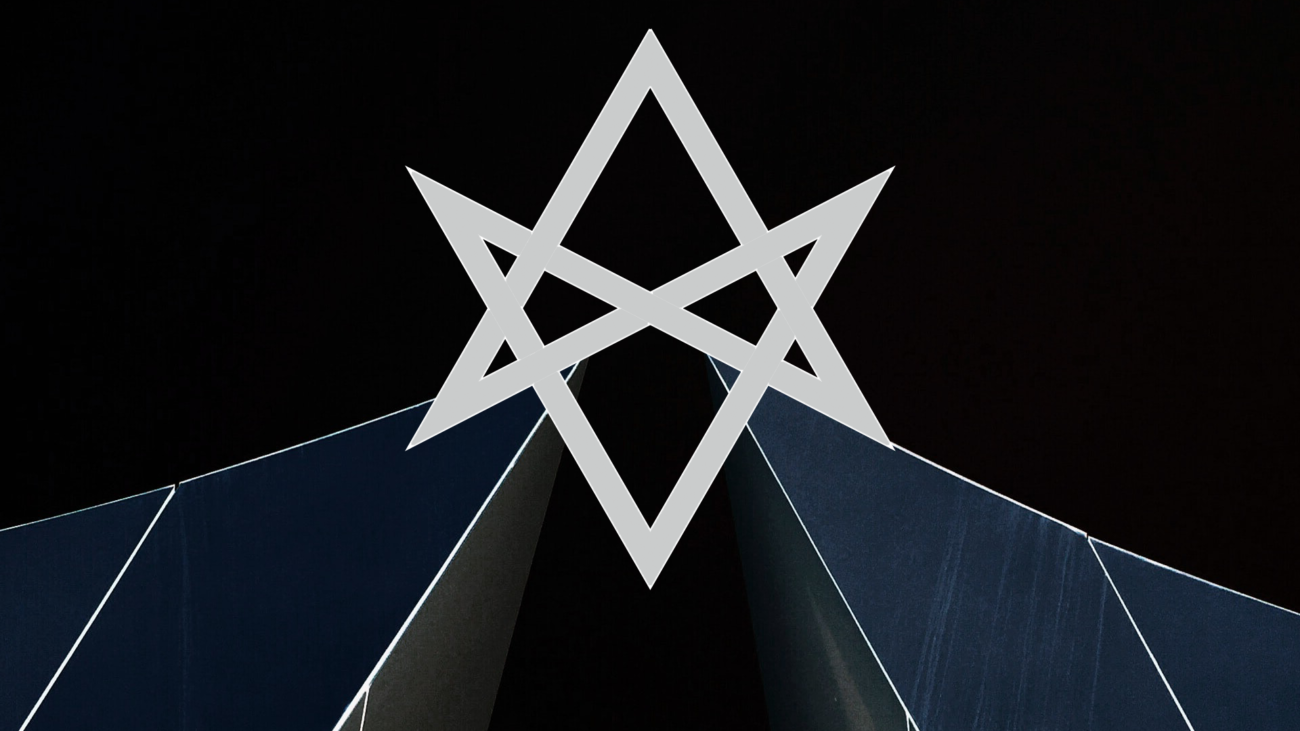These two “foundations” of Thelema do not always coexist peacefully and at times seem to be in tension with one another or even contradict one another.
The Three Feminine Principles in the Mass
Having covered the function of the three Lords in the Mass, I want to now cover the three feminine principles they’re the counterparts of.
The three feminine principles are most conspicuous in the Collects. There’s the Moon in the third Collect, the Lady in the fourth, and the Earth in the sixth.
Each feminine principle is the counterpart of a masculine principle. The Moon is the counterpart of the Sun, the Lady (ostensibly Nuit) is the counterpart of the Secret Lord (Hadit), and the Earth is the counterpart of Chaos (the sole viceregent of the Sun upon the Earth, i.e., the microcosmic counterpart of the macrocosmic Lord in the Universe).
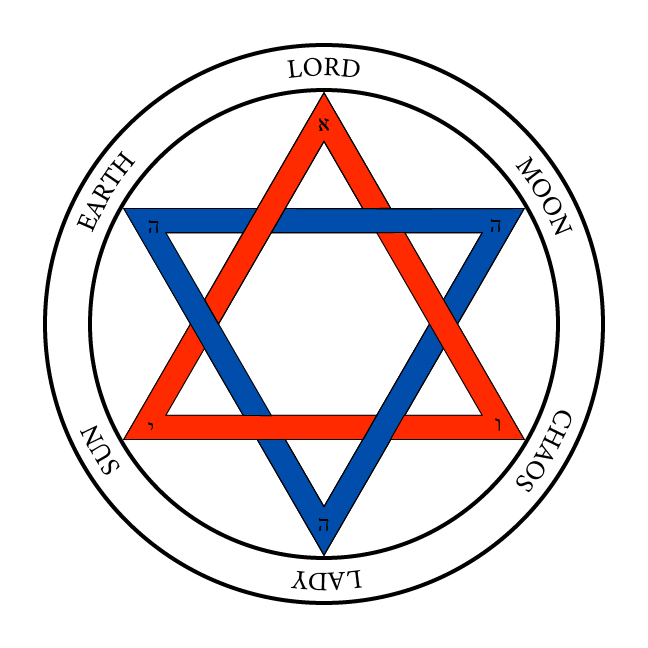
If we assume each of the three feminine principles can be represented by each of the three mother letters of the Hebrew alphabet, then it stands to reason that the Lady (Nuit) is א, mercury, or air; the Earth is מ or salt; and the Moon is ש, sulphur, or blood.
The function of the three feminine principles—which are also the three alchemical principles—is evinced in part III of the Mass, “The Ceremony of the Introit.” In terms of the performance of the ritual, this is actually the first part. It starts when the Deacon admits the congregants and ends with the congregants saying “So mote it be” after the Priestess consecrates the lance and declares the Lord (Chaos) to be present among us.
As I showed in the previous article, the purpose of the Ceremony of the Introit is to invest the Priest with the powers of the three Lords (Hadit, the Sun, and Chaos). In particular, its most important function is to devote the will of the Priest—as represented by his lance—exclusively to the grail of the Priestess. This perfects his will and sets it on a course, the natural terminus of which is its annihilation in the Cup of Babalon. But this process of investing the Priest with these functions and devoting him to the divine feminine is carried out entirely by the Priestess herself, aided by the two Children.
After the recitation of the Creed, the Priestess enters, flanked by the two Children. The first Child enters with the ewer and the salt. Salt is מ which is also the feminine principle of Earth. Then the Priestess (here called the Virgin) enters with the sword and the paten. The sword is א, mercury, or air; the paten is a solar symbol. Then the second Child enters with the censer and perfume, indicating ש, sulphur, or fire/blood.
Facing the congregation and Deacon, the Priestess says, “Greeting of Earth and Heaven!” and all give the Hailing Sign of a Magician, which is a symbol of the sacrament of marriage. She is in a sense declaring the purpose of the ritual, which is the union of the microcosm (earth) with the macrocosm (heaven), which will be carried out by means of the formula of IAO.
The Priestess places the paten on the altar before the graal. She is not in possession of the graal at this time, since she is not performing the function of Babalon. Her first function is mercurial as indicated by the sword (א, alchemical mercury, or air) and the serpentine circumambulations. As has been pointed out, the three and a half circumambulations indicate her identity with kundalini and her power to raise the Priest to his spiritual vocation.
To understand the next part, you need to look at Magick, Part Two, chapter IV, “The Scourge, the Dagger, and the Chain.” That chapter shows that the three alchemical principles as embodied in the three magical weapons are used to prepare the magician for a magical operation. The scourge is ש, sulfur, or fire. It’s used against the body to invigorate the Nephesh, to keep one awake and ardent. The dagger is א, alchemical mercury, or air. It symbolizes alertness and is the ability of the magician to know when he is on task (concentrated) or not. Finally the chain is מ or salt. It represents fixity of attention or mindfulness of the task at hand.
The Lustral Water! Let thy flood
Liber Pyramidos
Cleanse me—lymph, marrow, & blood!
The Scourge, the Dagger & the Chain
Purge body, breast & brain!
The Fire Informing! Let the Oil
Balance, assain, assoil!
Having struck herself with the scourge, let her blood with the dagger, and having put the chain around her neck, the magician would then anoint herself with the Holy Oil (see Magick, Part Two, chapter V). This consecrates the magician to the Great Work.
All of this happens in its own way in the Ceremony of the Introit.
First the Priestess draws her sword and pulls down the veil of the tomb. This is the only part of the ritual where the Priestess uses the sword. She’s using it to free the Priest from his natural condition, as represented by his entombment. As Crowley says in De Lege Libellum, that “which men call life is but a shadow of that true Life, [their] birthright, and the gift of the Law of Thelema.” In other words what we call life is more like death. We “feel little; what is, is balanced by weak joys” (AL I.31). Thelema is a spiritual path which leads us to live perhaps for the first time, but it requires a passage through what appears to most people as a kind of death. This spiritual death—erotic destruction—is what is dramatized in the Mass at the opposite side of the room at the altar. So the tomb and the altar spiritually and spatially balance one another. (See Magick in Theory and Practice, ch VIII, on how objects in a ritual ought to balance one another.)
But the journey begins with discernment. You have to know that there is something else besides the ordinary life in order to pursue the extraordinary one. That is in essence what the Priestess is doing on behalf of the Priest here. She is cutting away the veil of darkness around him and calling him forth to a new spiritual vocation. And of course this being a cultic rite, not a personal journey, his vocation is actually to administer on behalf of a congregation, i.e., “the breathren”.
When he asks how he shall be worthy to take up this vocation, she proceeds to purify him with water and the salt and consecrate him with fire and incense.
As Crowley says in Magick in Theory and Practice, “Purity means singleness.” It means fixing the mind upon the one task which must be accomplished in the magical ceremony. It is represented by the weight of the chain around the neck, which we have already seen is connected with מ (which is also elemental water) or alchemical salt.
As already mentioned, the scourge invigorates the Nephesh or the animal soul. It raises energy or generates ardency for the task. When the Priestess says, “Be the PRIEST fervent of body and soul!” the fire and incense are serving the same function as the scourge.
Then she adorns the Priest with the two mantles. The robe represents his function as Priest of the Sun; the crown represents his function as Priest of the (Secret) Lord Hadit.
At this point we might expect her to anoint him with the Holy Oil, thus signifying his readiness to unite the higher in himself with the lower. That’s not what she does, though. Instead she kneels and strokes the lance eleven times, thereby consecrating it to the Lord Adored (Chaos).
What I take from this is that the natural will thus perfected—i.e., devoted exclusively to Nuit—just is the higher part of the individual now ready to do the work of union or sacred marriage.
In other words, it’s not quite correct that the sex instinct is the Holy Guardian Angel. The sex instinct properly oriented and devoted to heaven is the means by which union with the divine will occur. A will thus perfected must inevitably cross the Abyss, thus annihilating itself and becoming its feminine opposite in the Mother Babalon.
In other words, the Priestess—who is “actually Virgo Intacta or specially dedicated to the service of the Great Order”—has now made the Priest like her through the Ceremony of the Introit. She has made him “virgin” or “chaste” unto the Lord. His sex instinct or natural will is now devoted exclusively to the most high and has thus been perfected.
Having accomplished that, the Ceremony of the Introit ends, and the Ceremony of the Opening of the Veil commences. Now their roles change. The Priestess is no longer the primary agent in the ritual; the Priest is. Taking her by the hand, he raises her. He now refers to her as “Virgin pure without spot”. Her function is no longer alchemical mercury. She is now ה final of the formula Tetragrammaton. He is no longer a natural man but now functions as ו of Tetragrammaton. Thus he seats her upon the altar, which we know from its crimson altar cloth is representative of Binah or the Throne of the Mother. She now represents Babalon, and the rest of the ritual is about how he will go about pouring all he is into her cup, thereby undergoing destruction in erotic union with her.
Liber V vel Reguli and the Formula of AHIHVH

I spent some time recently looking closely at Liber V vel Reguli along with the commentary and the early draft notes, and feel like I have come to a few insights which could be of use to others.
As I’ve shown before, one of the main themes of Crowley’s spirituality is the movement from speech to silence and back again. This could also be viewed as the expression of nullity (Ain of Kabbalah) into manifestation (the Tree of Life itself) and the individual’s path of return back to nullity. The first part of this equation expresses Thelemic cosmology, the latter Thelemic soteriology.
In Reguli these movements are dramatized and expressed in the formula LAShTAL. LA means “not,” while AL means “God”. LA and AL represent nullity in concealment and manifestation respectively, while ShT is the process that mediates between them.
In order for ShT to mediate between LA and AL, they have to conjointly share something in common between LA and AL while also adding new information.
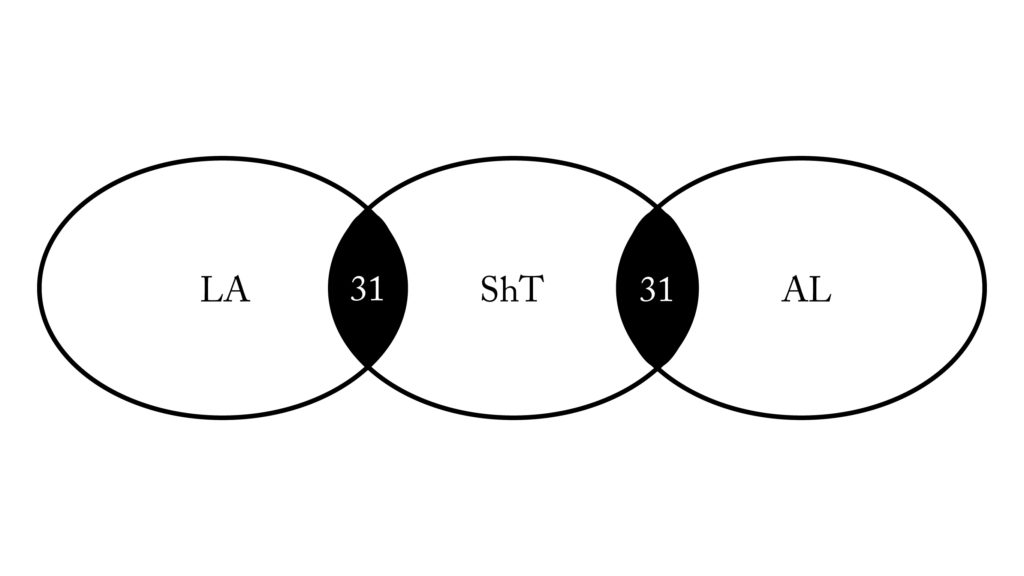
LA and AL both add to 31 by gematria. ShT also adds to 31 by way of the tarot cards these letters are attributed to. Sh or Shin is the Hebrew letter assigned to The Aeon, Atu XX, and T or Teth is assigned to Lust, Atu XI.
As someone recently pointed out to me, there is a tradition in the Golden Dawn, recorded in the Z1 document, of ST denoting an influence from Kether. ST is the Coptic letter ⲋ (“ⲥⲟⲟⲩ” or “soou”). Crowley continues this tradition by assigning this letter to Kether in 777, Column LI.
So by means of its association with 31 and Kether, ShT is identical with the (N)One at the foundation of Thelemic ontology and theology.
But ShT has an additional function. It also indicates the Beast and Babalon conjoined. It is a sexual formula. This sexual formula is indicated by how it is represented in Reguli on the human body and on the Tree of Life.
In the ritual, Aiwass, Therion, and Babalon are attributed to the cross paths of the Tree of Life: Daleth, Teth, and Pe respectively. The cross paths are important as they mediate between the Pillar of Severity and the Pillar of Mercy.
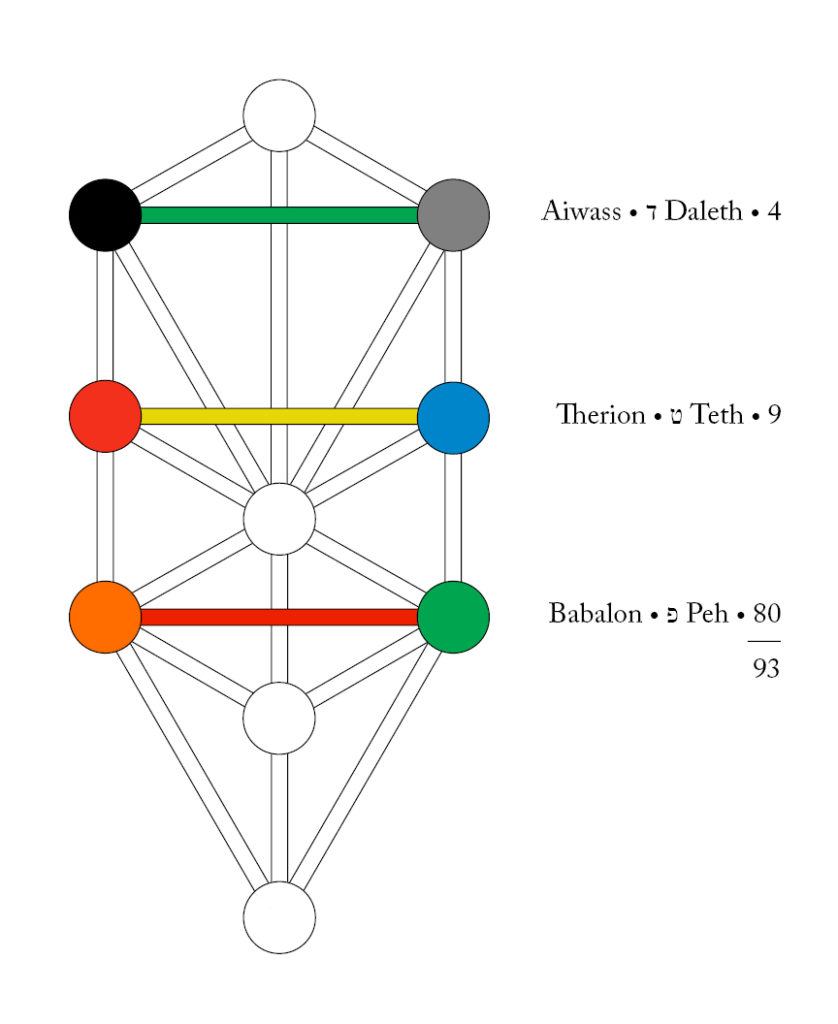
As taught in the Golden Dawn 4°=7□ ritual, the left pillar, the Pillar of Severity, is associated with the letter Shin, which is assigned to elemental fire, while the right pillar, the Pillar of Mercy, is Mem or elemental water. The Middle Pillar is then Aleph, which is elemental air. Fire is archetypally masculine, water feminine, and air androgyne.
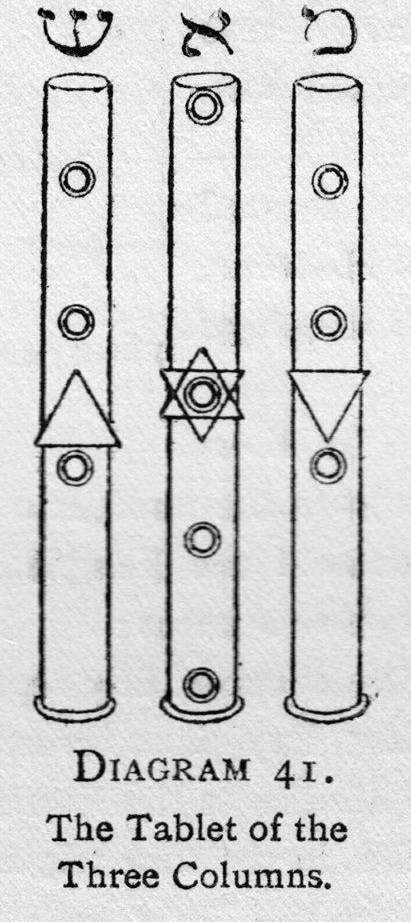
However, these sexual characteristics are not assigned to the pillars in a straightforward way. While the Pillar of Severity is fiery and masculine, the topmost sephira, Binah, is archetypally feminine. She is the supernal Mother. And opposite her, on the Pillar of Mercy, we find Chokmah, which is archetypally masculine, the supernal Father. They are “reflected” in Netzach (masculine-feminine) and Hod (feminine-masculine) respectively, as Kether is reflected in Tiphareth. This reflection occurs both horizontally across the Tree (Binah and Netzach and Chokmah and Hod are opposite each other across the Middle Pillar) and vertically down the Tree (they are opposite Tiphareth). The vertical and horizontal “components” of Liber V vel Reguli work with this double-reflection of sexual energy.
One can view this double-reflection of magical sexual polarity taking place on the Tree as a movement of energy down the Tree of Life from Kether into the subsequent Sephiroth along the paths. One androgyne current emerging from Kether, represented by the path of Aleph, becomes masculine upon reaching Chokmah. There it progresses down the tree along the archetypally masculine paths of Vau, Yod, Ayin, and Resh, into Yesod. In Yesod it is met by a complementary feminine path, originating with Beth’s entry into Binah, and progressing down the Tree along the paths of Cheth, Lamed, Nun, and Tzaddi.
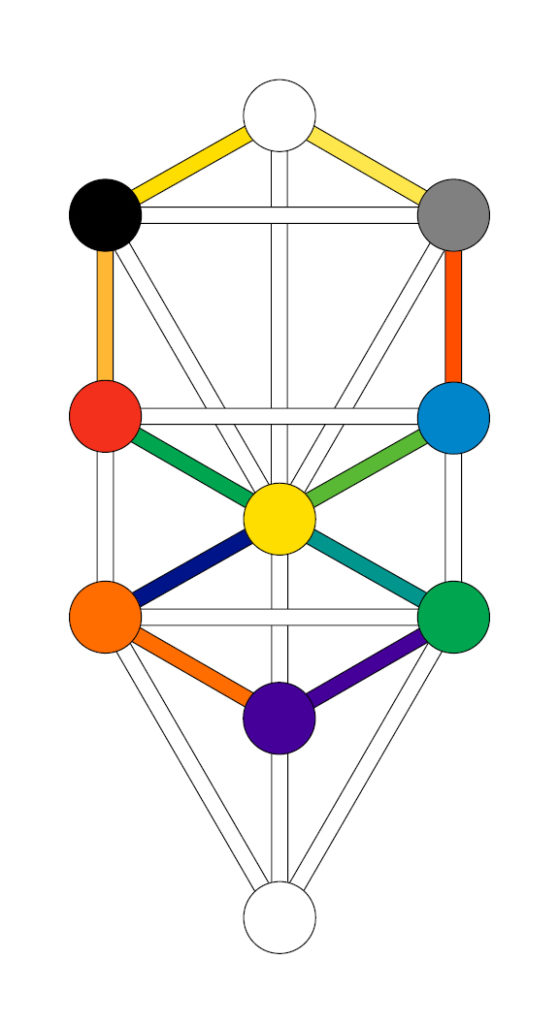
This exchange and “mixing in Yesod” is represented on the Art card, Atu XIV. Art is a hieroglyph of the path of Samekh, which links Yesod with Tiphareth. Here we see the Lion and the Eagle which have exchanged their colors as represented earlier on the Lovers card, Atu VI. If the paths on the Tree represent these essences or potencies, then they were exchanged at Tiphareth, a sphere which, among other things, is the site in which the Rose (Kteis) and Cross (phallus) are conjoined. The caldron is Yesod, which is linked with the sexual organs and the Muladhara cakra. We see spiritual air—presumably the Medicine of Metals—rising out of the caldron, represented by the arrow, as the Caput Mortuum (skull) drops to the bottom.
The cross paths are important to this process, because they are mediating the exchange of energies down the Tree. They are in a sense guiding and determining the separation and mixing of these sexual polarities. That these paths add up to 93 is significant. It tells us that the 93 magical current has something essential to do with the production of sexual polarity from out of androgyny and back again. It has to do with the movement of 0 to 2 (magick) and from 2 to 0 (mysticism), both as a personal spiritual journey and as a cosmological process. Aiwass, Therion, and Babalon are personages representing these governing principles.
For me personally, this is not simply theory. When I’m serving as Priest in the Gnostic Mass, I picture this exchange of energy occurring—moving down and wrapping around and joining mine and the Priestess’s hearts—at the consummation of the eucharist. We are linked energetically at the levels of mind (Daleth and Kether), heart (Teth and Tiphareth), and body (Peh and Yesod). The Tree of Life with the cross-paths can also be used as scaffolding for visualizations during sex magick workings.
If the horizontal component is governed by Aiwass, Therion, and Babalon, the vertical component is governed by Nuit, Ra-Hoor-Khuit, and Hadit. Nuit is associated with the Sahasrara cakra/Kether/the Three Negative Veils; Ra-Hoor-Khuit is linked specifically with the Anahata cakra and the paths of Teth, Yod, and Lamed (which add to 49), but also arguably with the entirety of the Tree in manifestation (hence Microprosopus); and Hadit is linked with the Muladhara cakra and Yesod and/or Malkuth (Crowley refers to this as the “seed” in his commentary).
The conjunction of Nuit and Hadit produces the godhead, Ra-Hoor-Khuit (or Heru-Ra-Ha, so as to include Hoor-paar-kraat). Hadit, as the consciousness or point of view of the individual, is implanted in Malkuth as a seed represented by Heh-final, the Virgin Daughter whose destiny is to be seated upon the Throne of the Mother (Binah). Crowley consistently related the three deities of the Book of the Law to the Tree of Life this way.
So one thing to take note of when attempting to understand LAShTAL is that it shares the same form or structure taken by these three personages in relation to the Tree of Life. You have two simple extremes mediated by a complex third thing sharing characteristics with both of the extremes. Indeed, the entire Tree of Life itself—or Ra-Hoor-Khuit—could be seen as a means of mediating between these oppositions.
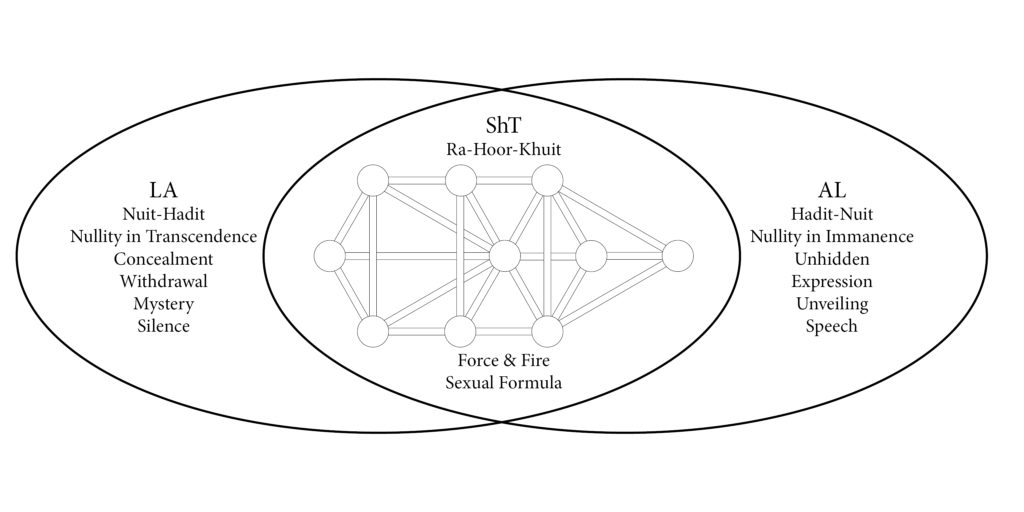
But how does the introduction of the horizontal component modify or inform this cosmological and theological process of the implantation, germination, and return of Hadit to the source?
The cross-paths enter into this as they are involved in the drawing of the Hexagram of Nature on the Tree of Life. Generally speaking, the hexagram is the symbol of the union of the individual with the divine, with the mirroring in the microcosm of the structure of the macrocosm. As such it is symbolic of the individual who has become divine. The cross-paths of Teth and Pe are involved in this hexagram—in fact are the only actual paths involved—as they form bases of the two interlocking triangles.
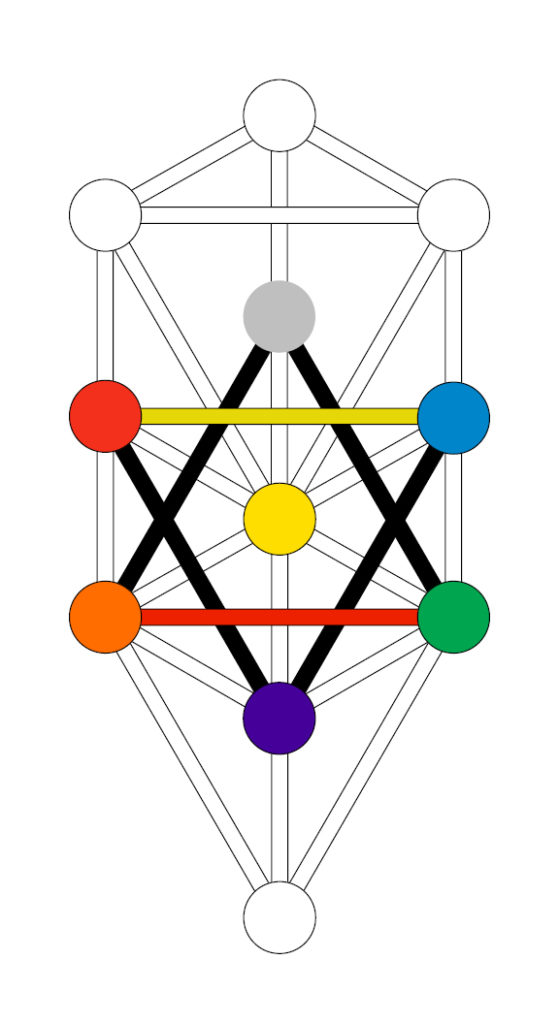
Typically the upward-pointing triangle represents fire and is therefore masculine, while the downward-pointing triangle is water and feminine. But a different connotation is suggested in Reguli where the base of the upward-pointing triangle is assigned to Babalon, and the base of the downward-pointing triangle is Therion. The polarities are reversed.
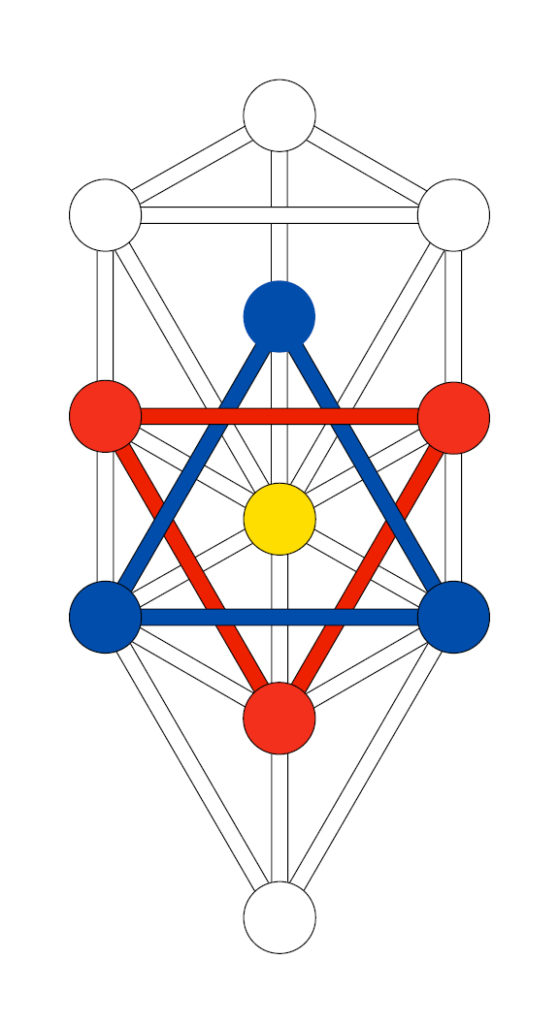
This suggests not so much the familiar Hexagram of Nature but rather the Magical Hexagram as described by Crowley in the Book of Lies, where fire points down and water up.
In the ordinary Hexagram, the Hexagram of nature, the red triangle is upwards, like fire, and the blue triangle downwards, like water. In the magical hexagram this is reversed; the descending red triangle is that of Horus, a sign specially revealed by him personally, at the Equinox of the Gods. (It is the flame desending upon the altar, and licking up the burnt offering.) The blue triangle represents the aspiration, since blue is the colour of devotion, and the triangle, kinetically considered, is the symbol of directed force.
Book of Lies, Chapter 69
Crowley explicitly associates force with the path of Teth in Reguli, as he associates fire with Shin. Hence ShT represents “force and fire”. In the context of the ritual, these triangles would interlock and interpenetrate around Tiphareth, representative of the Anahata cakra, Ra-Hoor-Khuit, and, as we saw earlier, Kteis-Phallus or the Rose-Cross.
As the upward-pointing blue triangle represents Babalon, the Mother, we could attribute the three Mother Letters (Aleph, Mem, and Shin) to its three points, as we might attribute the masculine trinity, IAO, to the three points of the downward-pointing red triangle. Their conjunction gives us the word AShIAVM, which has the same value as MShICh (Messiah) and NChSh (Nechesh, Serpent).
The Messiah or Anointed One affects the union between the individual and the divine. The Serpent in the Garden of Eden is the initiator of mankind into knowledge or gnosis. In Thelemic soteriology, this saving, initiating power is not one individual but rather the conjoining of two individuals, Therion (666) and Babalon (156). And the way in which this union between the divine and the individual is affected is sexual in nature.
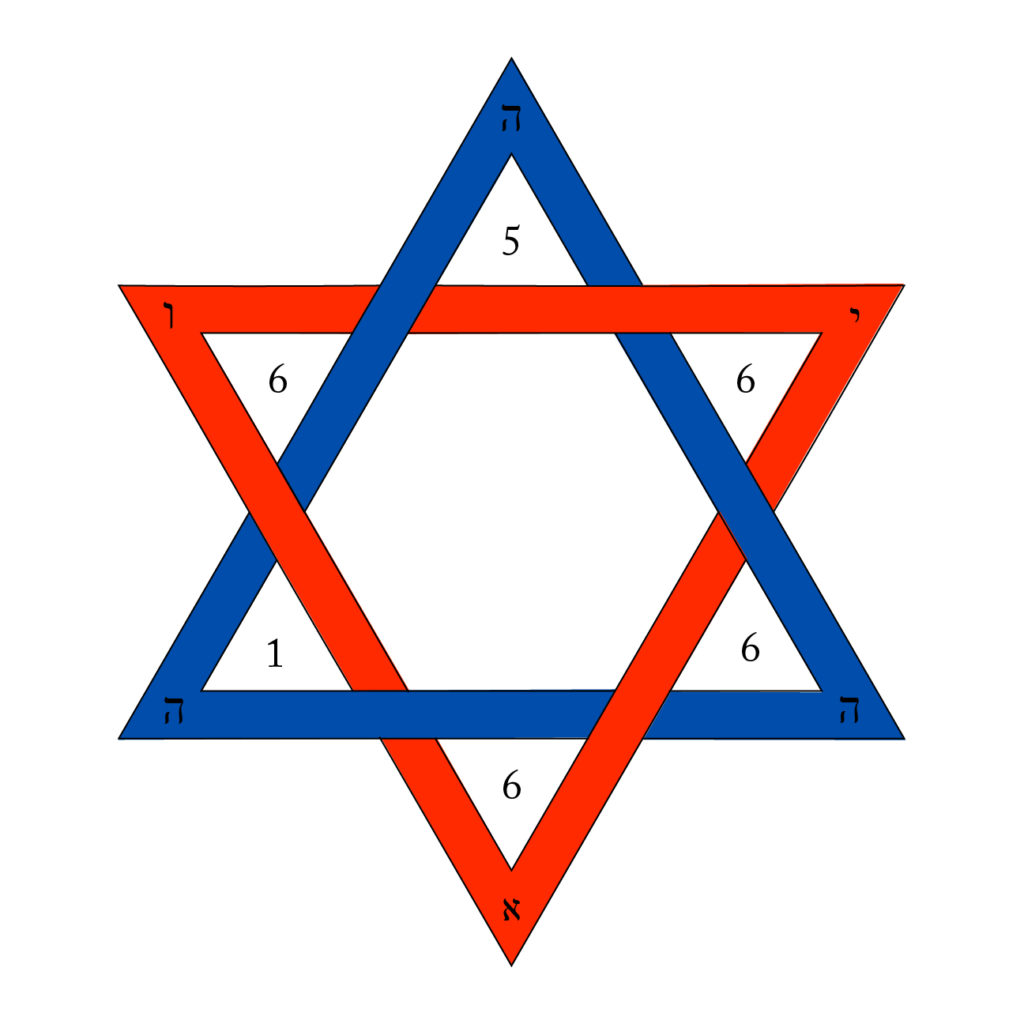
In this formula AShIAVM, the three mother letters are concealed by the letter Heh, giving us AHIHVH, the Great Name which is the conjunction of AHIH and IHVH.
AHIH is the godname of Kether. It represents existence in is most abstract quality or Macroprosopus. In the context of Reguli, it is LA, Nuit and Hadit conjoined.
IHVH represents god in manifestation or Microprosopus. It enumerates to 26 by gematria, which is 13 x 2. 13 is the enumeration of AChD or unity. IHVH therefore expresses unity (AL) by means of duality (ShT or Beast and Babalon conjoined). It is the way in which nullity expresses itself in manifestation or as the Tree of Life or 0=2.
Antonio Lau has come to a similar conclusion in his analysis of how the formula of AHIHVH relates to the Lesser Ritual of the Pentagram:
The conclusion would be that all the points of the Lesser Ritual of the Pentagram (32) on the whole create another Hexagram that symbolizes the Qabalistic Zero, radiating from the center of the Column and flooding the whole Circle with the Limitless Light of Ain Soph Aur. And the Hexagram is the formula of unifying opposites (positive and negative, active and passive, male and female), by the 0=2 Equation.
This sheds light on what it means that Reguli is meant to “invoke the energies of the Aeon of Horus.” The “first gesture” of the ritual—the drawing of the Elevenfold Seal—is depicting the unfolding process leading to the creation of the cosmos. It is also establishing the scaffolding—the cross-paths—that allow for the process of return. The “second gesture”—in which the Son raises the Daughter to the Throne of the Mother—is the familiar process of Tetragrammaton which, by means of sexual interaction between Son and Daughter, the process of return takes place. What Reguli adds to this conception is the idea that Nuit and Hadit (Daughter and Son) must become “sexually mature” as Babalon and Therion on their way of return.
AHIHVH is important for other aspects of Crowley’s spirituality. He relates it to the Lesser Ritual of the Pentagram. By means of the LRP it is indirectly connected with the production of the Medicine of Metals. The connection with the Medicine of Metals is made explicit through Crowley’s discussion of the production of the Eucharist of Six Elements in Magick in Theory and Practice Chapter 20. The production of this medicine is a secret guarded by the Sanctuary of the Gnosis of O.T.O. This formula is also the guiding structure behind Liber HHH, which describes some of the work of the Outer College of A∴A∴. At least one Thelemic author, J. Daniel Gunther, has made an extensive case for the AHIHVH formula being essential to a comprehension of Thelemic initiation in general. (See Initiation in the Aeon of the Child and The Angel and the Abyss.)
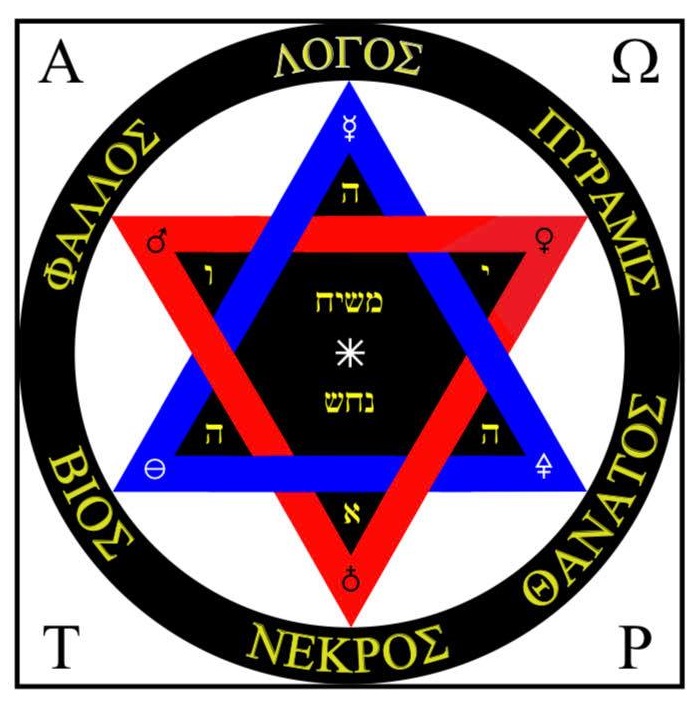
As I said in my recent talk on art and magick, when a magical formula is involved in so many disparate aspects of Crowley’s magick—especially when it illuminates mysteries of both A∴A∴ and O.T.O.—you can bet it is essential to an understanding of Thelemic spirituality generally. I hope to deal with this formula in greater depth in subsequent writings, exploring more fully its importance for Thelemic magick generally.
As for Reguli, my treatment of it here is not exhaustive. I have hardly dealt with the function of the cross-path of Daleth or how Aiwass figures into all of this. (There’s another hexagram that uses the path of Daleth as the base of a triangle.) I didn’t even touch on the elemental attributions of the deities/quarters, and I barely dealt with the significance of the cakras. But hopefully this shows the way in which Reguli is expressive of the underlying ontology and theology of Thelema and how the sex magick implicit in it relates to Crowley’s broader spiritual concern as expressed in the AHIHVH formula.
A Path with Heart
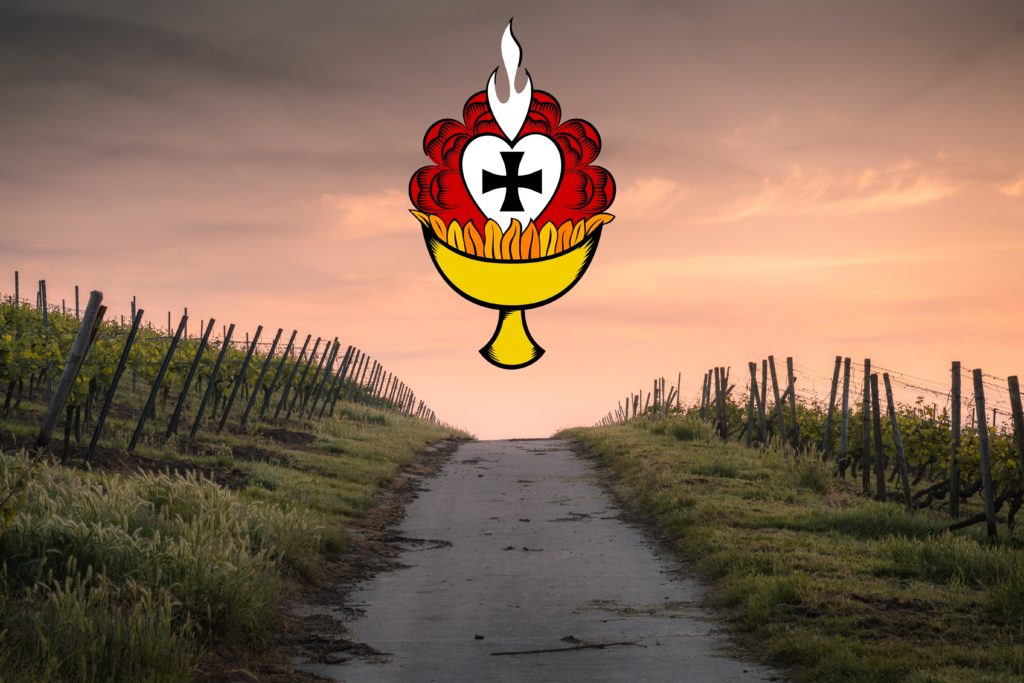
“To open the heart requires the capacity of courage, because courage is the capacity to carry fear.”
This past weekend, I had the pleasure of presenting on behalf of Horizon at Concentric Circles, an annual interfaith pagan conference.
The talk I delivered was on the subject of Thelema as a heart-centered path. Rather than approach Thelemic magick as a means of imposing one’s desires on the world, I chose to look at it from the perspective of removing arbitrary barriers around one’s heart.
With removal of one’s armor and acceptance of one’s vulnerability come opportunities for growth and joy.
I talk about how this is the path that leads to Our Lady Babalon and the summit of spiritual wisdom.
The Symbolism of the O.T.O. Lamen
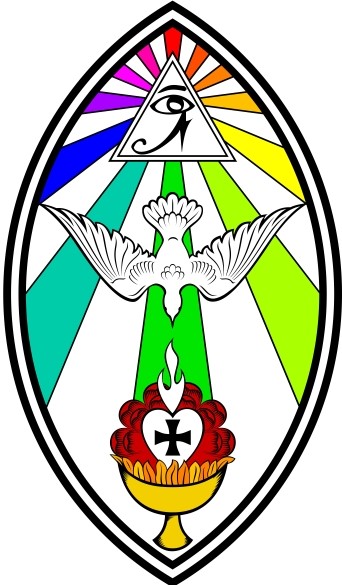
I spent a lot of time this weekend contemplating the lamen of O.T.O. (I was at a Kaaba Colloquium and seated much of the time in front of the podium.) It gave me some time to think about the symbols that appear in it.
One of the things that really struck me is how much symbolism of the Anahata chakra there is in the cup at the bottom of the sigil. The rose in the cup has two rows of six petals. The Anahata chakra is often represented as a lotus flower with twelve petals.
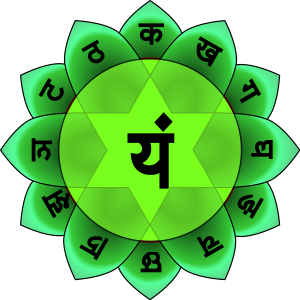
In the center of the rose is a flaming heart. The Anahata chakra is located in the center of the chest and is referred to the heart.
In Liber 777 column CXVIII, “Anahata (Heart)” is assigned to keys 4, 5, and 6, the Sephiroth Chesed, Geburah, and Tiphareth. Tiphareth is the 6th Sephira, and there are two rows of six petals each in the cup. In the center of the heart in the center of the rose, we see the cross. The mysteries of the Rose and the Cross are also associated with Tiphareth.
These three Sephiroth—Chesed, Geburah, and Tiphareth—form a downward pointing triangle, the interconnecting paths of which (Teth, Lamed, and Yod) add up to 49. The number 49 has a few occult meanings in Thelema. For example 49 is 72. Seven 7s appear in the sigil of A∴A∴. See also The Book of Lies, Chapter 49, where it is associated directly with Babalon.
This triad is also called “The Second Triad which is GOD” in Book of Lies chapter 0. The Tiphareth portion in particular is God in manifestation or Microprosopus, which we will return to later.
It’s also in this connection worth pointing out that the triangle formed by connecting Chesed, Geburah, and Tiphareth has the shape of a cup. This further strengthens its connection with Babalon and by extension the Priestess in the Gnostic Mass who fulfills the office of Babalon.
This grail of Babalon is also associated with Cheth, Cancer, and the number 69. In chapter 69 of The Book of Lies, we see this number associated with the Heavenly Hexagram, which we will return to shortly.
Switching focus to the Eye in the Triangle, we might associate it with the supernal triad of Kether, Chokmah, and Binah. They form a triangle whose interconnecting paths (Aleph, Beth, and Daleth) also add up to 7.
The eye itself can be thought of as the Eye of the Father, Horus. So while the lower portion of the lamen might be referred to the Priestess (by means of Babalon and the cup), the upper portion may be referred to the Priest.
The eye is also linked to the path of Ayin (which means “eye”). Like Cheth, Ayin also contains masculine and feminine archetypes, being associated with the hermaphroditic Baphomet. Neither the lamen of O.T.O. nor the offices of the Gnostic Mass imply strict gender dualities. This is in keeping with Crowley’s assertion in The Book of Thoth that
At first sight it would appear that the formula [of tetragrammaton] is the union of the extremely masculine, the big blond beast, with the extremely feminine, the princess who could not sleep if there was a pea beneath her seven feather beds. But all such symbolism defeats itself; the soft becomes the hard, the rough the smooth. The deeper one goes into the formula, the closer becomes the identification of the Opposites. The Dove is the bird of Venus, but the dove is also a symbol of the Holy Ghost; that is, of the Phallus in its most sublimated form. There is therefore no reason for surprise in observing the identification of the father with the mother.
We will return to his passage and the symbolism of the dove shortly.
The addition of Ayin (70) to the triangle itself (7) gives us 77, which has some significance in the context of O.T.O. being the enumeration of OZ, a goat.
So what we see in the two extremes of the lamen are the supernal triad of Kether, Chokmah, and Binah opposed to the triad of Chesed, Geburah, and Tiphareth. While the upper triangle refers to an active masculine-feminine (Ayin, OZ, the goat), the bottom triad refers to a passive masculine-feminine (Babalon, who receives every drop of blood in her cup). What about the dove between the two of them, seen descending from the Eye in the Triangle into the cup?
The dove has lots of significance loaded into it. By column XXXVIII in Liber 777, it is associated with the path of Daleth. The dove would then signify the divine love uniting the active masculine-feminine magical pole of the Priest (in his role as Chaos or Yod tetragrammaton) with the passive masculine-feminine magical extreme of the Priestess (in her role as Babalon or Heh tetragramaton). This unification occurs at the HRILIU moment of the Gnostic Mass. According to Liber 418, HRILIU is the “shrill scream of orgasm”. In The Heart of the Master it is described as “The Voice of the Dove”.
The dove is also symbolic of the Holy Spirit. (See Matthew 3:16, Mark 1:10, Luke 3:22, and John 1:32.) This same equation between the dove and the Holy Spirit shows up in the Anthem of the Mass. (“Glory and worship in the highest, Thou Dove, mankind that deifiest”) (This analysis is extended here.) Like the two extremes of the lamen, it is a symbol containing both male and female aspects.
For of the Father and the Son
The Holy Spirit is the norm;
Male-female, quintessential, one,
Man-being veiled in Woman-form.
Crowley extends the analysis in the passage from the Book of Thoth quoted above when he says, “The Dove is the bird of Venus, but the dove is also a symbol of the Holy Ghost; that is, of the Phallus in its most sublimated form.”
So we can think of the dove not only as the divine love uniting the supernal father with the supernal mother, but also as the male-female creative force or word of the Father—his seed or sperma—transmitted into the womb of the Mother. This is reflected in the Mass when, breaking a particle off of the host and elevating it, the Priest declares, “TOUTO ESTI TO SPERMA MOU. HO PATÊR ESTIN HO HUIOS DIA TO PNEUMA HAGION.” (“This is my Seed. The Father is the Son through the Holy Spirit.”)
As I have shown previously, the particle of bread represents the Iota, Yod, or “Secret Seed” of the Priest himself. It is identical with the Lord Secret and Most Holy of the Mass, whose office is represented by the serpent crown. When this seed is depressed into the cup, it becomes the Holy Spirit, Harpocrates, the Babe in the Egg, the creative breath, all of which are captured in the symbol of the dove. But just as importantly, Harpocrates or the Secret Self is also the Holy Guardian Angel.
This is an important point of doctrine for our Church, as the Holy Spirit of Ecclesia Gnostica Catholica is not the Holy Spirit of Christianity. Rather, it is a symbol of the Holy Guardian Angel of each person.
This interpretation is supported if we extend the Tree of Life symbolism implicit in the lamen. If the Eye in the Triangle represents the supernal triad of Kether, Chokmah, and Binah, and if the flaming cup represents the triangle of Chesed, Geburah, and Tiphareth, then the path connecting the two of them, by means of which the dove descends, would be Gimel. Of this path, Crowley, in The Book of Lies chapter 42, says:
The Masters of the Temple … come from the Great Sea, Binah, the City of the Pyramids. V.V.V.V.V. is indicated as one of these travelers; He is described as a camel … because “camel” is in Hebrew Gimel, and Gimel is the path leading from Tiphareth to Kether, uniting Microprosopus and Macroprosopus, i.e., performing the Great Work. The card Gimel in the Tarot is the High Priestess, the Lady of Initiation; one might even say, the Holy Guardian Angel.
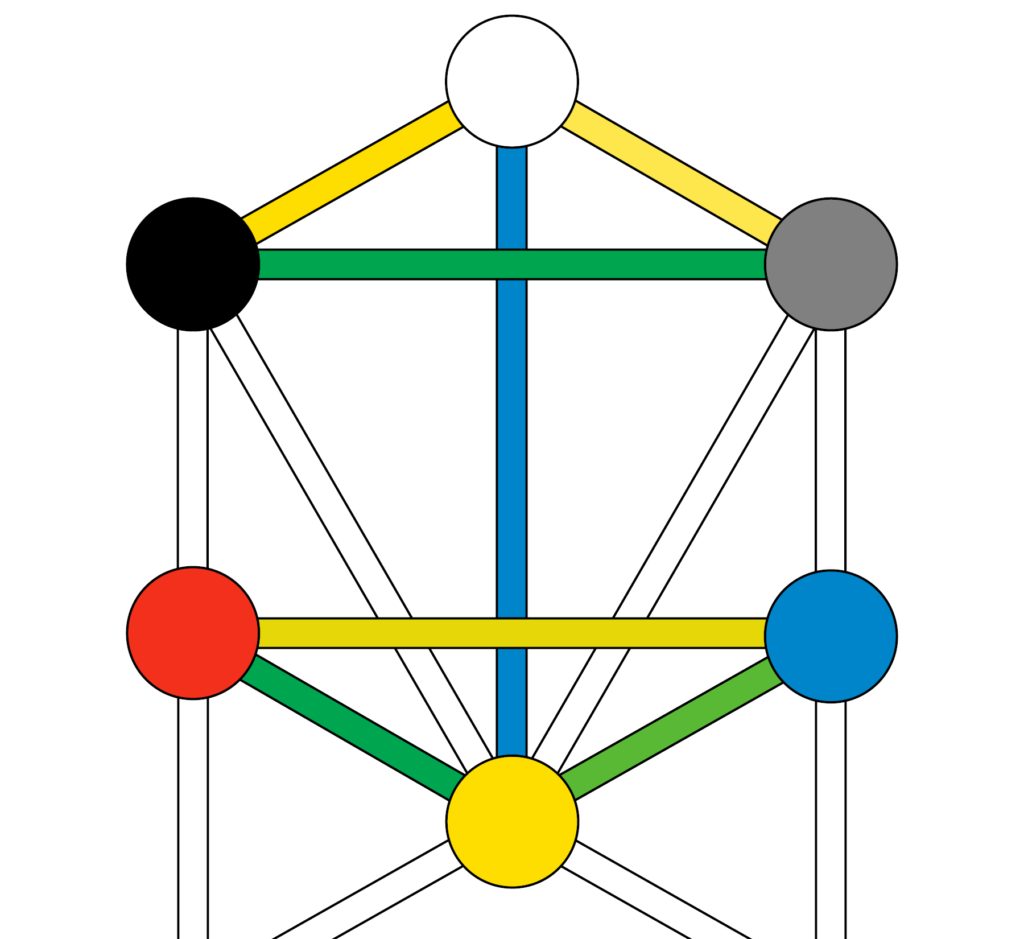
In this passage we have Crowley linking the path of Gimel not only with V.V.V.V.V. but also with the Holy Guardian Angel and the initiator. S/he (again, we see the masculine and feminine combined) is the One who mediates between the divine individual (microprosopus) and the supernal divine (macroprosopus), thereby enabling the candidate to perform the Great Work. This is the upward path, the Path of Return described in “One Star in Sight,” whereby the Son (the Angel) sets the Daughter (the aspirant) on the throne of the Mother (Binah).
But in the symbolism of the O.T.O. lamen, we do not see a journey upward. Instead, we see a journey downward. We see the dove of the Holy Spirit or the Holy Guardian Angel descending from the supernal triad of the Father into the cup, which is symbolic of microprosopus, God in manifestation. And again, this mirrors the symbolism of the Holy Hexagram we see described in The Book of Lies chapter 69: “Plunge from the height, O God, and interlock with Man!” The whole figure is described as a glyph of “the Great Work”.
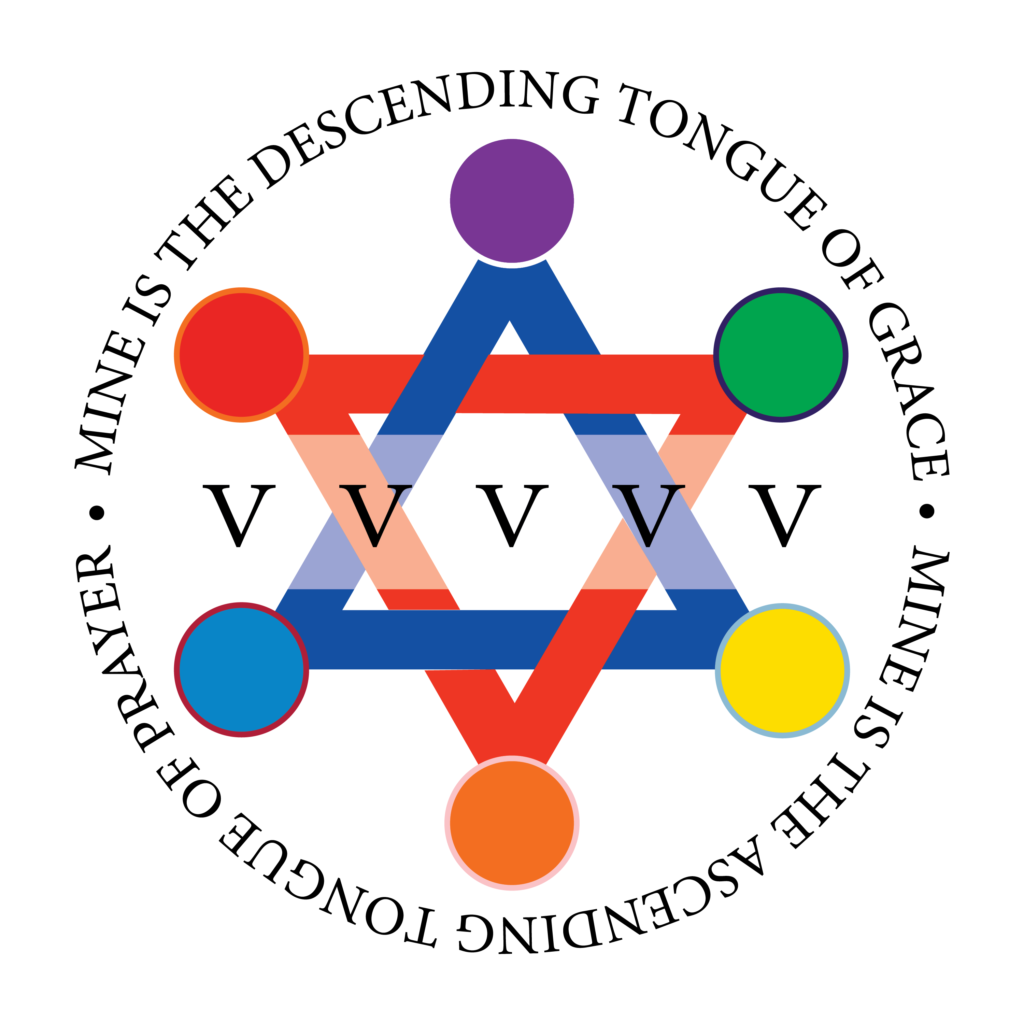
So in other words, in the lamen of the O.T.O., we are witnessing a symbol of the Great Work, this time not from the point of view of the candidate aspiring to Binah, but rather from the point of view of macroprosopus incarnating by means of the Holy Guardian Angel. Again, “This is my Seed. The Father is the Son through the Holy Spirit.”
This symbolism further reflects and reinforces my interpretation of Part VIII of the Gnostic Mass. Assuming the O.T.O. lamen has any connection with the central private and public rite of O.T.O., then the lamen indicates the same process at play in the Gnostic Mass where, by isolating the Secret Seed of himself, the Priest, in his role as Chaos, is incarnating his own Holy Guardian Angel. By consuming it, he is uniting himself with his HGA. The congregants are doing the same thing except perhaps in a more attentuated way. This seems to me the best way to make sense of Crowley’s claim in Magick in Theory and Practice chapter XX that:
[By doing eucharistic magick t]he magician becomes filled with God, fed upon God, intoxicated with God. Little by little his body will become purified by the internal lustration of God; day by day his mortal frame, shedding its earthly elements, will become in very truth the Temple of the Holy Ghost. Day by day matter is replaced by Spirit, the human by the divine; ultimately the change will be complete; God manifest in flesh will be his name.
This is the most important of all magical secrets that ever were or are or can be. To a Magician thus renewed the attainment of the Knowledge and Conversation of the Holy Guardian Angel becomes an inevitable task; every force of his nature, unhindered, tends to that aim and goal of whose nature neither man nor god may speak, for that it is infinitely beyond speech or thought or ecstasy or silence. Samadhi and Nibbana are but its shadows cast upon the universe.
But then if this same process is also reflected in the O.T.O. lamen, then it stands to reason that the central secret of O.T.O. probably also involves this same mystery of the incarnation of the Angel.
On the Dual Aspects of the Priest and the Eucharist in the Gnostic Mass
ABSTRACT
The Lord Secret and Most Holy in the Gnostic Mass is the Secret Root of the self, symbolized in the Mass by the serpent crown and the particle broken off the host. It is represented by I/Yod in the magical formula VIAOV. By being depressed into the cup of wine (the priest’s “blood”), it passes into pure potentiality or spirit, represented by the letter A in VIAOV. This is identical with it becoming Harpocrates or the Holy Guardian Angel. From there it moves back into manifestation, now with an added solar character. This is represented by O in VIAOV and is called the Lion-Serpent or BAPHOMET. BAPHOMET is therefore an eidolon of the Holy Guardian Angel of each, having an extroverted, solar nature and an introverted, serpentine nature. While the introverted aspect, the Lord Secret and Most Holy, reflects the Secret Self of the individual, the extroverted aspect, the Lord Visible and Sensible, represents that very same principle in manifestation, utilizing the process of life and death for its expression down the generations. It is by virtue of the Priest embodying both of these aspects (as symbolized by the mantles granted him by the Priestess) that he is able to transform a symbolic part of his own body into this eidolon for public use.
One of the curious features of Liber XV: The Gnostic Mass is the mention and invocation of two Lords. One of these two Lords corresponds with the Sun.
By the power of ☩ Iron, I say unto thee, Arise. In the name of our Lord the ☩ Sun
Thou that art One, our Lord in the Universe the Sun
Lord visible and sensible of whom this earth is but a frozen spark turning about thee with annual and diurnal motion
Let this offering be borne upon the waves of Æthyr to our Lord and Father the Sun that travelleth over the Heavens in his name ON.
Alongside this Lord Visible and Sensible, sometimes in the same passage, we find reference made to a Secret and Ineffable Lord.
I believe in one secret and ineffable LORD
By the power of ☩ Iron, I say unto thee, Arise. In the name of our Lord the ☩ Sun, and of our Lord ☩ …
Lord secret and most holy, source of light, source of life, source of love, source of liberty
Lord most secret, bless this spiritual food unto our bodies
The Priest of the Gnostic Mass represents both of these Lords and acts on behalf of both of them in the ceremony. We know this, because the Priestess bequeaths two mantles to the Priest at the beginning of the ceremony: the robe and the crown. Donning him with the robe, she says, “Be the flame of the Sun thine ambience, O thou PRIEST of the SUN!” Then placing the crown upon his forehead she says, “Be the Serpent thy crown, O thou PRIEST of the LORD!” By making him the Priest of the Sun, the Priestess is arguably also placing him in the role of CHAOS, who we learn from the first article of the Creed is “the sole viceregent of the Sun upon the Earth”. By making him Priest of the Lord (Ineffable), the Priestess now also associates the Priest with those qualities of the Lord mentioned in the second Collect: “Lord secret and most holy, source of Light, source of Life, source of Love, source of Liberty”.
In chapter V of Magick in Theory and Practice, Crowley indirectly associates this Lord Secret and Most Holy with the I of the VIAOV formula by means of these four attributes, and by extension with Yod .
Iota is the secret Life ………….. Serpent
— Light …………. Lamp
— Love ………….. Wand
— Liberty ……….. Wings
— Silence ……….. Cloak”
These symbols are all shewn in the Atu “The Hermit”.They are the powers of the Yod, whose extension is the Vau.
Yod is the Hand wherewith man does his Will.
Crowley expands on the relationship between this Secret and Ineffable Lord and the individual later in the same chapter:
The first process is to find the I in the V—initiation, purification, finding the Secret Root of oneself, the epicene Virgin who is 10 (Malkuth) but spelt in full 20 (Jupiter).
This can be understood as a brief description of the process of initiation in the context of A∴ A∴ whereby one attains to the Knowledge and Conversation of one’s Holy Guardian Angel. But this formula also has special significance for the Mass. In Part VI of the Mass, the Priest had declared the host to be his own body with the words “TOUTO ESTI TO SÔMA MOU” (“this is my body”). Then in Part VIII of the Mass, he breaks off a piece of this host and declares it to be his “seed”: “TOUTO ESTI TO SPERMA MOU” (“this is my seed”). This should be understood as an example of the Priest (V) isolating the Secret Root of himself (I) as symbolized by the bread particle. But this Secret Root or sperma of the Priest is identical with the Lord Secret and Most Holy. It is by virtue of his office of Priest of the (Ineffable) Lord that the Priest is able to perform this function in the ceremony. The symbol of this office further strengthens this association, as the serpent is in the shape of a spermatozoon.
The particle is placed on the tip of the lance, and, the Priest clasping the cup, the Priest and Priestess together depress the tip of the lance with the particle into the wine in the cup. Shortly thereafter, the Priest says, “O Lion and O Serpent that destroy the destroyer, be mighty among us.” From the third article of the Creed, we know that the Lion-Serpent invoked here is none other than BAPHOMET. Crowley’s commentary on the formula of VIAOV sheds light on this section of the Mass as well:
This Yod in the “Virgin” expands to the Babe in the Egg by formulating the Secret Wisdom of Truth of Hermes in the Silence of the Fool. He acquires the Eye-Wand, beholding the acting and being adored. The Inverted Pentagram—Baphomet—the Hermaphrodite fully grown—begets himself on himself as V again.
The bread particle or sperma—the Lord Secret and Most Holy—upon being depressed into the “blood” of the Priest in the cup “expands to the Babe in the Egg,” which earlier in this chapter Crowley associates with Harpocrates. In the New Comment on AL I.7, Crowley states:
Hoor-paar-Kraat or Harpocrates, the “Babe in the Egg of Blue”, is not merely the God of Silence in a conventional sense. He represents the Higher Self, the Holy Guardian Angel. The connexion is with the symbolism of the Dwarf in Mythology. He contains everything in Himself, but is unmanifested
In other words, the isolated “Secret Root” of the Priest—his sperma—has become a Holy Guardian Angel. This was accomplished “by formulating the Secret Wisdom of Truth of Hermes in the Silence of the Fool”. Hermes or Thoth is associated with the path of Beth on the Tree of Life, whereas the Fool is associated with the path of Aleph. Both extend from/lead into Kether. Crowley explains the connection between Harpocrates, Aleph, Beth, and Kether in a passage from the Book of Thoth:
Arriving at highly sophisticated theogony, there appears a perfectly clear and concrete symbol of this doctrine. Harpocrates is the God of Silence; and this silence has a very special meaning. (See attached essay, Appendix.) The first is Kether, the pure Being invented as an aspect of pure Nothing. In his manifestation, he is not One, but Two; he is only One because he is 0. He exists; Eheieh, his divine name, which signifies “I Am” or “I shall Be”, is merely another way of saying that he Is Not; because One leads to nowhere, which is where it came from. So the only possible manifestation is in Two, and that manifestation must be in silence, because the number 3, the number of Binah-Understanding-has not yet been formulated. In other words, there is no Mother. All one has is the impulse of this manifestation; and that must take place in silence. That is to say, there is as yet no more than the impulse, which is unformulated; it is only when it is interpreted that it becomes the Word, the Logos. (See Atu I.)
We might say that the Holy Spirit or Holy Guardian Angel—represented here by Aleph—is released from the sperma—represented by I or Yod—upon its dissolution in the “blood” or wine. This resultant Holy Spirit is identical with Kether, which itself represents All (Ain Sof) = None (Ain). It is pure potentiality which can only be turned into some state of affairs by means of the utterance of the Word. To put the same thing another way, the Holy Spirit has been created by the movement from 2 to 0, which we might call the process of mysticism. It can now be turned into a state of affairs by the opposite movement from 0 to 2, which is called magick. The first process is comprehended in the path of Aleph (the Fool), the second in the path of Beth (the Magus). The first requires silence, the second incantation or the Word.
In connection with the same passage from The Book of Thoth we read:
The Fool is also, evidently, an aspect of Pan; but this idea is shewn in his fullest development by Atu XV, whose letter is the semi-vowel A’ain, cognate with Aleph.
This is mirrored in the passage from MITAP we were just considering:
He acquires the Eye-Wand, beholding the acting and being adored. The Inverted Pentagram—Baphomet—the Hermaphrodite fully grown—begets himself on himself as V again.
That the Gnostic Mass is aimed at the production of such a being is given in its title of Liber XV, XV being the Roman numeral associated with the Devil card depicting Baphomet. Baphomet is described in the Creed and in Part VIII of the Mass as the Lion-Serpent. In his commentary to AL II.8, Crowley says, “Harpocrates is also the Dwarf-Soul, the Secret Self of every man, the Serpent with the Lion’s Head.” Again, we see the close association between the Holy Guardian Angel and the Eucharist of the Mass, but rather than being in its unmanifest form as Aleph, it has now developed into its manifest form of Baphomet or the Lion-Serpent. The original serpent or spermatozoon of the Priest dissolved into (N)one, only to reemerge with an added leonine (solar) aspect. It was reduced to 1 (the particle), then to none (at HRILIU becoming Aleph), now to reemerge as 2 with the dual form of Lion-Serpent.
The Lion is associated with Leo, which is ruled by the Sun (Lord Visible and Sensible). This is Horus or the extroverted aspect of Heru-Ra-Ha or the Holy Guardian Angel. The serpent is one of three emblems associated with Scorpio (the others being the eagle and the scorpion). Scorpio is attributed to the path of Nun, to which is assigned Atu XIII, Death. Death is the ordeal of the Second Grade of A∴ A∴, Adeptus, wherein Knowledge & Conversation occurs. The serpentine aspect of the Eucharist therefore represents the destructive or corrosive influence of the Holy Guardian Angel on the aspirant. “Serpent” is also the meaning of “Teth,” the path on the Tree of Life associated with Leo and Atu XI which depicts Beast and Babalon conjoined. This is the introverted or Harpocrates aspect of Heru-Ra-Ha. The union of these two symbols in the path of Teth strongly implies that we are not dealing here with two separate individuals (Lords) but rather with the same principle under two descriptions.
Notice how the dual character of the Eucharist as Lion-Serpent reflects the dual roles of the Priest as Priest of the Sun and Priest of the Lord. It is only by virtue of serving both of these roles that the Priest is able to create a Eucharist embodying both of these principles.
I would like to suggest that while the Lord Secret and Most Holy is the Secret Self or Secret Root of each individual, the Lord Visible and Sensible is the outward, visible, characteristic effect of that very same Self as it utilizes life and death for its own continuance “from generation to generation”. From the other side, while the Sun represents the Word Made Flesh, consciousness in time, or God manifest as sexual generation, the Secret Lord represents the utterly transcendent aspect of that process, that which maintains and promotes its self-identity paradoxically through the very same power of death which nullifies its vehicle of manifestation.
As we have seen previously, that BAPHOMET is an eight-lettered name is significant, as 8 is the number associated with Hod on the Tree of Life. This associates the Eucharist of the Mass with Mercury or Christ. This Mercurial Eucharist is a reflection of the original Mercury which served as the seed or sperma of the operation. It is precisely by virtue of its mercurial function that the Lord Secret and Most Holy is able to “continue knowledge from generation unto generation” as described in the fifth Collect. Since each one of us exists by virtue of such a transmission, the Eucharist is able to serve as an eidolon of the saving power of the Holy Spirit within each of us. Hence BAPHOMET as Lion-Serpent or God Made Flesh serves as an appropriate Christ figure for our cult.
Babalon and the Mass
In the Gnostic Mass, the Priest takes up the role of CHAOS, who is associated with Chokmah. He serves the function of the logos or the word, which is also the phallus or the creative aspect of the Father. From his own body, he produces the seed (sperma). By means of an alchemical process, this seed will be transformed into the Mercurial Serpent, the Baphomet or Christos, the Philosopher’s Stone, etc. This product of the first operation is strongly associated with the Sun, with the path of Ayin, with Hod, but also with Kether and even the entire Tree of Life (if you draw the number 8 on it). But before diving deeper into the nature of the product, I’d like to first examine the process itself, in particular the role played by the Priestess.
If the Priest is taking up the work of CHAOS and the spiritual significance of Chokmah, then his counterpart the Priestess takes up the role of BABALON and the spiritual significance of Binah. What is her contribution, and what does that contribution imply about the nature of the God-Man produced by the operation?
In the Creed we recite, “And I believe in one Earth, the Mother of us all, and in one Womb wherein all men are begotten, and wherein they shall rest, Mystery of Mystery, in Her name BABALON.”
As compared with the treatment BABALON gets in The Vision and the Voice, this is rather terse and tends to understate her importance in the spiritual system of Thelema. But I think that has less to do with the importance of BABALON herself than the context. In The Vision and the Voice, Crowley was documenting his ascent across the Abyss to the grade of Magister Templi. There, BABALON is considered initiator. In the Gnostic Mass, by contrast, she serves as a cosmological or metaphysical principle which is relied upon in the context of a discrete alchemical operation.
This remark will make no sense to those who think the Gnostic Mass is a crossing-the-Abyss allegory culminating in the candidate (the bread particle) merging with the all-mother (the wine in the cup). But it will make perfect sense if you accept that, by at least Part VI of the Mass, the Priest is not a candidate aspiring to Binah but rather the representative of CHAOS performing a magical operation with the Priestess in her role as BABALON, with the desired effect being the production of a Divine Being at Tiphareth. In other words, the operation of the Mass is meant to move the Word down the Tree of Life from Chokmah to Tiphareth where it becomes incarnated as God Manifest. If the particle is consciousness as such, then it is consciousness-in-time (the Sun) in its finished state in the cup. But then what is it about the cup—the symbol of Our Lady—that allows this to take place?
From the article of the Creed, we find BABALON identified with Earth, Mother, and Womb. The wording suggests she is the sub-lunary context into which we are born, wherein we live, and which we eventually pass away into. In other words, she is nature.
But what is nature from a Thelemic perspective? I would like to suggest that it is neither the object studied in the field of physics, nor is it merely inert matter. Neither of these designations fits with the spiritual function of Binah, which BABALON is also associated with. The function of Binah in Kabbalah is to transform pure thinking as such (associated with Chokmah) into something like a determinate set of concepts of creation. So if we think of Chokmah as corresponding with the neoplatonic idea of nous or of pure mind, then Binah corresponds with the concept of the world-soul, nature inwardly considered as a hierarchical system of ideas or categories of existence.
Importantly, Binah represents the first point in the movement from out of Ain/Ain Soph where limitation and hence form are introduced. Ain, Ain Soph, and Kether are words for a formless All or One or None. Chokmah is this pure (N)one reflected in thinking. Binah is where differentiation is first introduced. The thought of creation (which is something like a mere urge at Kether and Chokmah) now receives articulation. It is presumably for this reason that Crowley associates Binah with the Vissudha chakra which is at the throat. It is at the throat that thoughts are articulated into speech.
So in the figure of BABALON, we see the union of the concept of nature with the concept of form or formation. While this appears to be an odd pairing, it in fact harkens back to the ancient Greek concept of nature which Aristotle articulated in the Physics, particularly in Book B.
The ancient Greek word for nature was phusis, from which we get our word physics. While we tend to think of nature as various stuff (natural things, things of nature, etc.), Aristotle said that phusis is first and foremost a principle of development (arche kineseus). The function of this principle in each natural thing (phusei onta) was to cause it to change in such a way that it comes into its end (telos). This end or finished state was understood as a particular kind of appearance (eidos) or form (morphe).
So for example, the function of the nature of an oak tree is to guide the development of an acorn into a full-grown oak by way of its intermediate stages. The nature of the oak (the image or form of the full-grown oak) serves as a kind of blueprint (paradigma) for change, so that the change is not chaotic but is rather orderly and results in the proper end (the full-grown tree). To put it another way, the nature of the tree is responsible for delivering it into its final form or appearance, which is the full expression of its being as an oak. This makes natural growth a circular process from form (implicit) to form (explicit) back to form (implicit) again in the appearance of the new acorn.
This explains why Aristotle said that the being of a natural thing is its form or appearance (morphe) and not the matter (hule) composing it. Things are intelligible to us by virtue of their ends. What differentiates an action such as running from another action such as rhetoric is the end it aims at. The same thing goes for growing things. They’re differentiated by the final form or appearance they aim at in their growth. Matter is only of secondary importance here. The delivery of the thing into its final form requires the presence of things like food, air, water, and sunlight, but these are merely enabling conditions. The essence or being of the thing is always its form or final, outward, full-grown appearance. It is that image “lurking in the background” which drives change in a particular direction and hence constitutes the characteristic movement or development of the thing which differentiates it from other things.
Incidentally, this is why Aristotle makes the rather odd proclamation that actuality precedes potentiality. On the face of it, the statement is false. It makes more sense when you realize that the word Aristotle uses for actuality (energeia or entelecheia) actually means something like “being in the work [ergon]” or “being in the end [telos],” whereas the word for potentiality—dunamis—has the connotation of matter (hule) or the workshop that something is made in where there are tools and raw materials laying around. Placing something into its end always takes priority (ontologically) over the means or circumstances under which it is done, and therefore “actuality precedes potentiality”.
Now we’re in a position to understand much better the spiritual function served by the Priestess in the Gnostic Mass—as well as “the feminine” in any magical operation.
While the Priest provides the material (hule) for the operation in the form of the seed or particle, it is the function of the Priestess to give that seed form (morphe)—to in-form it—in the “womb”. She is responsible for taking the seed and “delivering” it (like a mother or midwife) into appearance (eidos). In the context of the Mass, that which is delivered into manifestation is the God-Man, which is associated with Tiphareth, the point on the Tree of Life where God is manifest for the first time. So while the Priest is responsible for the potentiality or potency of the Christos, it is the Priestess who delivers Him into appearance or form, and therefore she is responsible for His being.
You can see this on a very concrete level in the Mass itself. The particle is crumbly. It lacks integrity. The cup has definite borders. It provides integrity.
(For that matter, compare the oaths of the Minerval and I°s, which correspond with Chokmah and Binah respectively by their chakra attributions. It’s the exact same thing, only now the candidate is the crumbly particle being supplied with integrity and therefore with the possibility of fulfilling an end.)
But by delivering the seed into manifestation, BABALON or the Priestess also delivers it to death. This is because there is no way to deliver into manifestation without also introducing becoming as a condition. A beginning (genesis) is a change from one thing into another. While things abide in beingness, they also keep changing. This change tends toward decay and ultimately death or passing back out of existence. As the German philosophers Hegel said in his Science of Logic, for finite beings “the hour of their birth is the hour of their death.” Due to the conditions that must be put into place for the introduction of something into the world, to enter the world is to immediately incur the penalty of death. This is captured in the nature of BABALON herself as feminine creator-destructor. It is also captured in the two-sided nature of the “sword” leading from Tiphareth up to Binah.
What this means is that the product of the Mass—the eucharist—has both the qualities of life and death, as these are unified in every manifest being. But it is more than this. For while Christ comes from blood and water, there is also the Holy Spirit, the third witness on Earth. This dove-serpent which deifieth man is subject to conditions of life and death. But by means of gross generation (biological reproduction), this spirit is able to utilize the process of life-death for the purpose of its own self-expression and manifestation down through the ages, thereby transcending those very same conditions. Like the example of the eidos of the oak tree moving from implicit to explicit and back again, we are witnessing here another circular process. The Holy Spirit separates from itself in its transmission, yet this separation is the very act by which it maintains its transcendental integrity. “The secret of generation is death.”
And while the blood is a reflection or image of the Father, and the water is a reflection or image of the Mother, the Holy Spirit is a reflection or image of God. It is an image or eidos which, just like the image or eidos of an oak tree, has paradigmatic power over the being it stands in relationship to. It calls it forth into its full-blown, most true configuration. While for an oak tree, that image is merely the fully grown oak, for an individual it is their true self. In other words, the serpent-Christ emerging from the Eucharistic operation is the Augoeides. By consuming the eucharist, you unite yourself with your genius or Angel. This is why Crowley says continually doing Eucharistic magic will inevitably lead toward Knowledge and Conversation.
